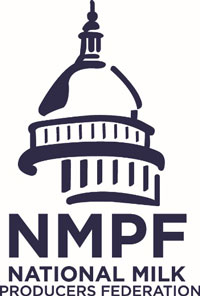
NMPF Reflects on 100 Years of Leadership at Federation's 99th Annual Meeting
?
 Kicking off a year-long centennial commemoration, the leadership of the National Milk Producers Federation today reflected on the organization's many achievements on behalf of dairy farmers, and noted continuing challenges ranging from assuring humane animal care to reforming federal immigration laws.
Kicking off a year-long centennial commemoration, the leadership of the National Milk Producers Federation today reflected on the organization's many achievements on behalf of dairy farmers, and noted continuing challenges ranging from assuring humane animal care to reforming federal immigration laws.Speaking at the Federation's 99th annual meeting here, Board Chairman Randy Mooney and President and CEO Jim Mulhern also unveiled an updated NMPF logo (shown at right) and a booklet chronicling the organization's 100 years of leadership on behalf of dairy producers.
The updated logo retains an image of the Capitol - used by the organization for half a century - but with a refreshed look. "A new century and new challenges call for a new, more modern design," said Mulhern.
The MooneyMulhern presentation marks the beginning of NMPF's 100th year, as the organization was founded in Chicago in 1916. "As our work today demonstrates, leadership is a journey, not a destination," said Mooney. "It's not just a word on a piece of paper; leadership is the tangible result of hard work."
In the past century, NMPF has recorded numerous legislative victories, including enactment of the Capper-Volstead Act in 1922, and the establishment of federal milk marketing orders in the 1930s. It was instrumental in the creation of the dairy price support program in the 1940s and convinced Congress to create the mandatory dairy check-off program in the 1980s.
But the two NMPF leaders related how past achievements reflect on current issues facing dairy producers.
In the last few years, one of those was the need to create a new and better federal safety net
for dairy farmers, now known officially as the Margin Protection Program. This catastrophic risk management program protects against worst-case scenarios like the Great Recession, Mooney said. NMPF conceived of the program after dairy farmers lost billions of dollars in equity in the 2008-2009 recession. The organization then lobbied Congress to include it in the 2014 farm bill. Ten months in, more than 55 percent of America's dairy farmers are enrolled.
"Without question, the program has its challenges, challenges we continue to work to address," said Mulhern. "But it's important to recognize that the program was designed as a producer insurance safety net, not an income enhancement program. . . . And for those wondering how MPP stacks up against its predecessor, the old MILC program would not have paid a penny this year to any dairy farmer, anywhere in the country."
The pair touched briefly on the self-help program Cooperatives Working Together, which was recently extended for through 2018. CWT helps its members to export key products like American-type cheese and butter. So far in 2015, the program has helped export the equivalent of 1.3 billion pounds of milk production.
In addition to economic issues, the need to counter imitation dairy products has been a long-time concern for the Federation. NMPF continues to urge the government to crack down on the misuse of dairy terms for non-dairy items, such as soy and almond "milk." The revamp of the REAL® Seal brand has helped inform consumers of the benefits of original, American-made dairy products, Mulhern said.
Another very recent major accomplishment has been the conclusion of negotiations over the Trans-Pacific Partnership, a trade deal between the 12 countries that border the Pacific Ocean. Access to foreign dairy markets was one of the more controversial points, and the issue wasn't resolved until the last day of the negotiations. Though final details are still being reviewed, Mulhern called the early results a victory.
"It appears that we have successfully prevented the very real risk of a harmful agreement that would have sacrificed U.S. dairy farmers' interests as chits in a high-stakes poker game," he said.
NMPF is also working with the USDA on revising federal dietary guidelines, which are being updated this year. New research has shown that saturated dairy fats are not as unhealthy as once thought. Mulhern also mentioned the Federation's efforts to relax restrictions on chocolate milk in schools through this year's child nutrition reauthorization bill.
More recently, animal health and environmental concerns have come to the forefront of
NMPF's list of issues. The National Dairy FARM program, launched in 2009, continues to evolve to promote the best practices of dairy farmers.
"The FARM program quantifies the great steps that farms contributing more than 90 percent of the U.S. milk supply are taking to care for their herds," said Mulhern. "No other sector in livestock has as comprehensive or widely adopted program as ours."
NMPF has plenty of other objectives to tackle in the next 100 years, said Mooney. The country is dealing with a failed immigration system, as farmers struggle to obtain the workforce needed to milk cows and perform other agricultural jobs. The organization also continues to challenge EPA's Waters of the U.S rule, even as it develops other means to improve water and air quality on farms.
Mooney and Mulhern toasted other milestones, as well. Dairy Management Inc. and the U.S. Dairy Export Council turned 20 this year, and the National Dairy Council has been educating the public on the nutritional value of dairy products for 100 years.
The National Milk Producers Federation (NMPF), based in Arlington, VA, develops and carries out policies that advance the well being of dairy producers and the cooperatives they own. The members of NMPF's cooperatives produce the majority of the U.S. milk supply, making NMPF the voice of more than 32,000 dairy producers on Capitol Hill and with government agencies. For more on NMPF's activities, visit our website at www.nmpf.org.
11.8.2015